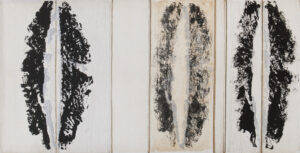The “Imprints” of the title perhaps represent Toti Scialoja’s best-known artistic season. And they are imprints, those fixed on canvas by the Roman artist, which, responding to an «awareness of the unknown» (in the curator’s words), distance him from formal expressiveness. Very well curated by Giuseppe Appella, the exhibition, hosted in the solemn rooms of Galleria dello Scudo in Verona with around thirty works from the Toti Scialoja Foundation, leads the visitor on a free interior journey that Scialoja emanates on large dimensions.

Toti Scialoja. “Impronte”, installation view at Galleria dello Scudo, Verona
In a testimony reported by the curator, Toti Scialoja in this creative period «filled a paper sheet with color, turned it onto the canvas and printed it by clapping hard with his hands». This is the technique that leads to two obvious impossibilities: correcting and diluting over time. In fact, as the artist said in New York in 1960, «the imprint is a rush against and at the same time a coming towards reality», thus certifying the physical pressure necessary to implement it and the lightning instantaneousness of the gesture. “Sabato sera” and “Rosa Rosae”, works from 1958, are the first fruits, when visiting the exhibition, of this fatality of the gesture. The rose is an element also present in Scialoja’s poetic writings (who was also a poet, starting from the years focused on by this exhibition) and the sand almost forces you to get closer to the canvas to investigate its countless and random streaks.

Toti Scialoja, “Ininterrotto”, 1958, sabbia e vinilico su tela di canapa, 113,6 x 145,3 cm, courtesy Galleria dello Scudo e Fondazione Toti Scialoja
“Ripetizione sabbia” is in my opinion the central fulcrum of the exhibition itinerary. The title evokes the repetitiveness of the gesture, the imprint that replicates itself in a flow that truly leaves you breathless and immobile in a silently museum-like atmosphere. Scialoja’s material charge glides with energy to leave imprints that send us back to a very physical melee with the fragility of the canvas. “Ininterrotto”, also from 1958, already from the title shows how the creative flow and the gesture on canvas are as unstoppable as the blood flow, confirming the seriality of the imprint and how the «physical pressure and the bodily weight are total but at the same time blind» (from a newspaper of the time). “Come vuoi” is from 1960 and here the artist confirms his preference for imprints fixed in the breadth of the dimension. There are signs of verticality in the visual space, a slightly more rarefied verticality that anticipates the creativity of the following years. The title seems to suggest the superiority of the imprint which autonomously decides what it means about itself, the different degrees of visibility of pigmentation, the alternation between presence and absence.

Toti Scialoja, “Issoire argento”, 1961, vinavil, garza, sabbia e corde su tela, 106,5 x 206,2 cm, courtesy Galleria dello Scudo e Fondazione Toti Scialoja
With a small temporal and geographical leap, the artist in the meantime lives and works in Paris. “Issoire Argento” from 1961 also shows us a small material variant: the gauze and cotton are added to the other materials and the cotton canvas. The spatiality of the footprints also changes: here they are vertical, the void and the fullness chase each other to compose an abstract triptych. Scialoja’s predilection for absolutely unconventional canvas dimensions also fascinates the viewer’s eyes, with unusual decimals that reinforce the sense of anonymity of the subject chosen by the artist in this period. Finally, it is also worth mentioning the physical geography that accompanies Scialoja’s happy years: from Procida to Greenwich and then to Paris, in a continuous flow that takes him – as it emerges from the observation of the Parisian works – from the absence of forms to urgency to communicate shapes and rhythm. This exhibition heralds the presentation, in the Gallery, of the General Catalog 1940-1998 of pictorial and sculptural works: a publication that will bring order to Toti Scialoja’s artistic edifice.
Info:
Toti Scialoja. Impronte
16/12/2023 – 30/03/2024
Galleria dello Scudo
Via Scudo di Francia 2, Verona (VR)
www.galleriadelloscudo.com

is a contemporary art magazine since 1980






NO COMMENT